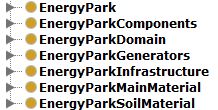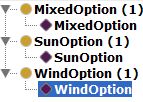Ontology for a Renewable Energy Park
containing road, tunnel, dam, wind park and solar plants
In the following we give a description for what context we created an ontology, of what use an ontology can be when programming a parametric model, what difficulties occur when combining different ontologies, and of which segments the particular ontology consists of.
What is the context?
The context is a renewable energy park and its components. The Renewable Energy Park is located in an environment where a valley and a river meet each other. It is thought of that the valley can be located at different climate zones. The Park includes five different engineering components: a dam, tunnel, street, various solar plants and wind turbines. The different components are linked to each other and are also influenced by the climate and the measurements of the valley.
What is an Ontology?
Ontologies are taxonomies. That means that ontologies contain vocabularies to structure information via “the definition of basic concepts in a domain” and the “relations among them” (Noy et al. 2001, p. 1) In other words ontologies describe concepts in a domain. A domain is a certain space that stores information on a certain topic. (i.b., p. 2) The presented ontology offers a taxonomy of the designed energy park, its possible alterations and its individual components, properties and individuals. We created it to have an overview over what has been implemented via Blender/Sverchok and can be seen as a structural plan of what can be seen on the 3D pictures.
What is it used for?
Ontologies are used to share science about structure of information, enable reuse of domain knowledge, and also make the assumptions of the specific domain explicit. In this particular case, the ontology is needed for a better understanding of the structure and connections within the energy park and its specific individual components. The featured energy park consists of a road, a tunnel, a dam, various solar plants and a wind park. Because all these components somehow have a link between each other the information about those links is stored in the ontology. Also the hierarchy or direction of influence is part of the ontology; it shows in an adaptable way how incremental changes of one part can alter one of the other parts. For an example, the ontology could be used to understand what sort of materials are used in the different parts of the park. Or it can be used to see how the environment of a certain type of valley and its belonging climate would influence the number of windturbines that should be installed to make efficient use of the surrounding.
How is the Ontology important to understand the Renewable Energy Park?
The Ontology we created is an attempt to present the knowledge of the concepts and intersections in the Renewable Energy Park we created. Because there are different engineering product models involved. The challenge is especially to understand the intersections of each of the featured engineering products and their model.
Challenges?
Challenges occurred in the process of combining the individual ontologies. This combination was required because previously all featured engineering products had been designed individually. They had to be aligned to each other in a way that they would fit together logically. This was not easy to sort out at first glance. This originated mainly from, what has been described before, that before all members of the group had worked on their specific ontological model of their chosen engineering product individually. The challenge at that point was rather on thinking about the structure and connection within this one chosen engineering product than in the connectivity to other ontologies. This was particularly obvious when reading the names, all ontologies would use leastwise slightly different names for similar concepts. Also because of the characteristics of the different engineering products the focus on what is important and what can be overseen was different. Another challenge occured that we had to create an environment in which all of our engineering products would fit in together purposefully. This environment also had to be part of the ontology as it influences the parameter of all the other engineering products. After trying to merge all the old ontologies and adding the environmental aspects, we found out that our solutions would not fit perfectly togther. This made us decide to start from scratch; we build a whole new ontology to overcome all the challenges and include all important aspects of all the existing ontologies into the new one and added the parts for the environment.
Communication, Collaboration, Coordination?
To overcome these challenges we had to think about communication, collaboration and coordination of the different engineering products to get a better understanding of how the combined ontology has to look like. We started by designing a systems sketch, to understand the most important intersections, relations and to have an idea about the hierarchy. While at the same time we had been working on the implementation of the comibination of all engineering products and our chosen environment we used both logical informations from what came out of our systems sketch and what we learned from combining models in Blender/Sverchok to understand better what sort of links had to be established in the ontology. The next paragraph describes how the newly built ontology is organised.
Important Parts of the new ontology?
Classes
The important classes of the ontology are described in the following. Starting from top class level, we included classes for the Energy Park itself “EnergyPark”, a class for the important parts of the components named “EnergyParkComponents”, one for the domain “EnergyParkDomain”, a whole class for all the energy generating engineering systems “EnergyParkGenerators”, the infrastructure components are stored in “EnergyparkInfrastructure”, two classes are reserved for the important materials featured in the energy park, the class “EnergyParkMainMaterial” is about the main construction materials, the class “EnergyParkSoilMaterial” features the materials that build the consistence of the ground.
figure 1: Top Classes
The class “EnergyPark” contains the three design options which depend on the chosen climate zones. The designed energy park, and its respective designs use the information that is stored in the classes “EnergyParkMainMaterial”, “EnergyParkComponents”, “EnergyParkSoilMaterial”, “EnergyParkDomain”. The featured climate zones we chose are an option for sunny climate, one for a zone with particular windy days and a mixed option, where both sun and wind are common weather scenarios.
figure 2: Design Options
In “EnergyParkComponents” are included the energy and infrastructure system components. The class has therefore two subclasses “EnergySystemComponents”, which list all the energy systems, belonging to solar, water and wind and a universal components aspect. The subclass ” InfrastructureComponents” which entails the aspects of the energy grid, the street and tunnel.
figure 3: Energy Park Components
“Energy ParkDomain”, describes the “ClimateDomain” consisting of the three climate Zones MixedClimate, SunnyClimate and WindyClimate. Also it describes theValley Domain with its RiverDomain and the SlopesDomain.
figure 4: Energy Park Domains
The “EnergyParkGeneratos” class comprise the three possible energy generators; they unify all the components, that are important to build each single energy generating system. They get their information from the class “EnergySystemComponents”. Same logic is applied at the subclass “EnergyParkInfrastructure”.
figure 5: Top classes “EnergyParkGenerator” and “EnergyParkInfrastructure”
As shown on the picture below, the classes “EnergyParkMainMaterial” and “EnergyParkSoilMaterial” contain the materials mainly used for the construction and for the soil of the environment of the energy park.
figure 6: Material classes
Object Properties
Our object property hierarchy contains four different object properties and its inverses. The featured object properties are “hasComponents”, “hasDomain”, “hasMainMaterial”, “hasSoilMaterial”, the domain of them is The “EnergyPark” and their range the respective class. The names of the inverses are “isComponentOf”, “isDomainOf”, “isMainMaterialOf”, “isSoilMaterialOf” with the domain of each class and the EnergyPark as the range. The sublasses are oriented on the classes in our ontology.
figure 7: Object Properties
Individuals
With respect to the class “DesignedEnergyPark” we included three data property assertions and filled in the information we thought suitable for our three design options. The property assertions we chose are: the wind force which is related to a number of windturbines, the sun intensity influences the number of solar plants featured, and at last the width of the valley that alters the length of the dam.
figure 8: Data Properties
figure 9: Individuals by type
LITERATURE
Noy, Natalya F. and Mc Guiness, Deborah L. (2001). Ontology Development 101: A Guide
Creating Your first Ontology.








